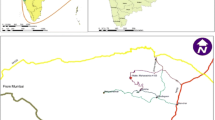Abstract
Kerala has been witnessing a large number of slope failure issues nowadays. After 2018 and 2019 floods, due to the landslide activities occurred in Kerala hill regions, people are getting aware of the seriousness of the slope instability problems. Factors such as geomorphology, slope angle, terrain curvature, slope length and steepness, soil type and land use or land cover are considered to affecting slope stability. The present study concentrates on the stability of Kattipara and Meppady regions of hill soil slopes. 2018 Karincholamala landslide comes under Kattippara region, and 2019 Puthumala landslide occurred at Meppadi region. The study area faces several slope failure issues. Rainfall is the primary triggering factor of slope failures in the region. Human-made activities of deforestation, constructing high rise buildings at slopes and mining explorations take part in making slopes more vulnerable to failure. Disturbances of soil due to vehicle motions, quarrying, construction activities, and earthquakes can affect the dynamic stability of slopes. Before performing the stability analysis under static and dynamic loading conditions, strength properties of soils collected from those regions are determined after conducting the experiments. SLOPE/W software using Limit equilibrium and pseudo static methods are used to obtain the factor of safety of slopes. Results are indicating that the soil slopes are about to fail under static as well as pseudo static conditions if the soils along the slopes are submerged below the piezometric line.
Access this chapter
Tax calculation will be finalised at checkout
Purchases are for personal use only
Similar content being viewed by others
References
Thampi PK, Mathai J, Sankar G, and Sidharthan S (1998) Evaluation study in terms of landslide mitigation in parts of Western Ghats, Kerala. Research report submitted to the Ministry of Agriculture, Government of India. Centre for Earth Science Studies, Government of Kerala, Thiruvananthapuram, India
Arca MCQ, Lorenzo GA (2018) Landslide hazard mapping using limit equilibrium method with GIS application of roadway traversing mountain slopes: the case of Kitaotao Bukidnon, Philippines. J Nepal Geol Soc 55:93–101
Wang X, Xia T, Zhang L, Gao M, Cheng K (2020) Field geological investigations and stability analysis of Duanjiagou landslide. ISPRS Int J Geo-Inf 9:23. https://doi.org/10.3390/ijgi9010023
Montrasio L, Valentino R, Meisina C (2018) Soil saturation and stability analysis of a test site slope using the shallow landslide instability prediction (SLIP) Model. Geotech Geol Eng 2018(36):2331–2342. https://doi.org/10.1007/s10706-018-0465-3
Gutiérrez-Martín A, Herrada MÁ, Yenes JI, Castedo R (2019) Development and validation of the terrain stability model for assessing landslide instability during heavy rain infiltration. Nat Hazards Earth Syst Sci 19(721–736):2019. https://doi.org/10.5194/nhess-19-721-2019
Pandit K, Sarkar S, Samanta M, Sharma M (2016) Stability analysis and design of slope reinforcement techniques for a Himalayan landslide. In: Conference proceedings on recent advances in rock engineering. https://doi.org/10.2991/rare-16.2016.16
Kuriakose SL, Sankar G, Muraleedharan C (2009) History of landslide susceptibility and a chorology of landslide-prone areas in the Western Ghats of Kerala in India. Environ Geol 57:1553–1568
Rahardjo H, Li XL, Toll DG, Leong EC (2001) The effect of antecedent rainfall on slope stability. Geotech Geol Eng 19:371–399
Jibson RW (2011) Methods for assessing the stability of slopes during earthquakes—a retrospective. Eng Geol 122: 43–50
Mandal S (2015) Assessing cohesion, friction angle and slope instability in the Shivkhola watershed of Darjiling Himalaya. Res J Earth Sci 3
Karhn J (2004) Stability modeling with slope/W: an engineering methodology, 1st edn, 17 pp
Author information
Authors and Affiliations
Corresponding author
Editor information
Editors and Affiliations
Rights and permissions
Copyright information
© 2021 The Author(s), under exclusive license to Springer Nature Singapore Pte Ltd.
About this paper
Cite this paper
Aswathi, P., Rangaswamy, K. (2021). Stability Analysis of Kattipara and Meppady Regions of Hill Soil Slope. In: Sitharam, T.G., Jakka, R., Govindaraju, L. (eds) Local Site Effects and Ground Failures. Lecture Notes in Civil Engineering, vol 117. Springer, Singapore. https://doi.org/10.1007/978-981-15-9984-2_18
Download citation
DOI: https://doi.org/10.1007/978-981-15-9984-2_18
Published:
Publisher Name: Springer, Singapore
Print ISBN: 978-981-15-9983-5
Online ISBN: 978-981-15-9984-2
eBook Packages: EngineeringEngineering (R0)




